The Foley Arms closed suddenly in January 2010. The hotel’s history had begun exactly 200 years earlier, at a time when Great Malvern was developing into an important spa town. The Georgian-style coaching inn was designed for John Downs by Samuel Deykes. It was originally named the Downs’ Hotel, but was soon renamed The Foley Arms, in honour of Edward Foley. He was lord of the manor and responsible for building the Coburg Baths, the Pump Room and the Royal Library next to the Foley Arms – which formed the hub of the fashionable health resort.
A photograph and text about Thomas Franklin.
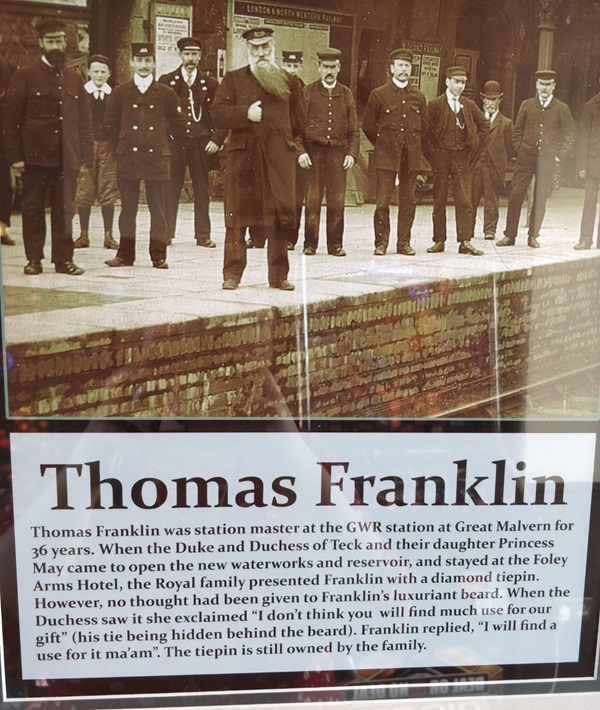
The text reads: Thomas Franklin was station master at the GWR station at Great Malvern for 36 years. When the Duke and Duchess of Teck and their daughter Princess May came to open the new waterworks and reservoir, and stayed at the Foley Arms Hotel, the Royal family presented Franklin with a diamond tiepin. However, no thought had been given to Franklin’s luxuriant beard. When the Duchess saw it she exclaimed “I don’t think you will find much use for our gift” (his tie being hidden behind the beard). Franklin replied, “I will find a use for it ma’am”. The tiepin is still owned by the family.
Photographs and text about George Bernard Shaw.
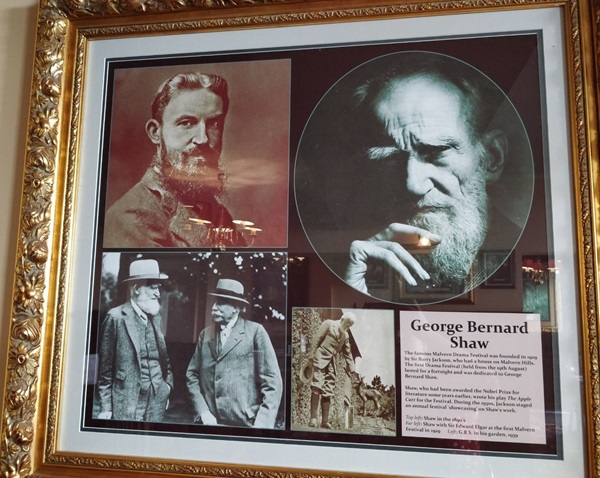
The text reads: The famous Malvern Drama Festival was founded in 1929 by Sir Barry Jackson, who had a house on Malvern Hills. The first Drama Festival (held from the 19th August) lasted for a fortnight and was dedicated to George Bernard Shaw.
Shaw, who had been awarded the Nobel Prize for literature some years earlier, wrote his play The Apple Cart for the Festival. During the 1930s, Jackson staged an annual festival ‘showcasing’ on Shaw’s work.
Top left: Shaw in the 1890s
Far left: Shaw with Sir Edward Elgar at the first Malvern Festival in 1929
Left: GBS in his garden, 1939.
Photographs and text about Santler.
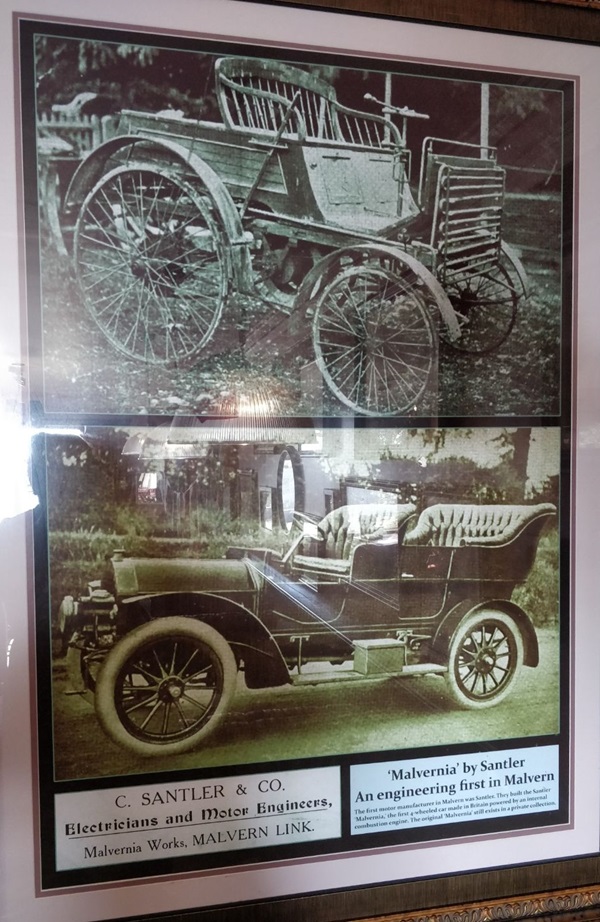
The text reads: The first motor manufacturer in Malvern was Santler. They built the Santler Malvernia, the first 4-wheeled car made in Britain powered by an internal combustion engine. The original Malvernia still exists in a private collection.
A photograph and text about the Morgan Three-wheeler.
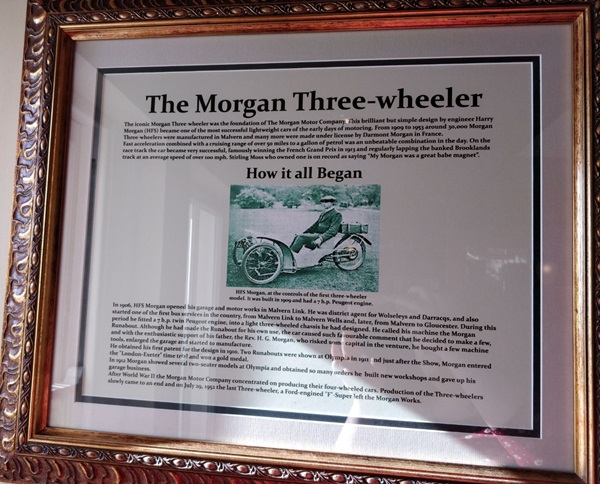
The text reads: The iconic Morgan Three-wheeler was the foundation of The Morgan Motor Company. This brilliant but simple design by engineer Harry Morgan (HFS) became one of the most successful lightweight cars of the early days of motoring. From 1909 to 1953 around 30,000 Morgan Three-wheelers were manufactured in Malvern and many more were made under license by Darmont Morgan in France.
Fast acceleration combined with a cruising range of over 50 miles to a gallon of petrol was an unbeatable combination in the day. On the race track the car became very successful, famously winning the French Grand Prix in 1913 and regularly lapping the banked Brooklands track at an average speed of over 100mph. Stirling Moss who owned one is one record as saying “My Morgan was a great babe magnet”.
In 1906, HFS Morgan opened his garage and motor works in Malvern Link. He was district agent for Wolseleys and Darracqs, and also started one of the first bus services in the country, from Malvern Link Malvern Wells and, later, from Malvern to Gloucester. During this period he fitted a 7 h.p. twin Peugeot engine, into a light three-wheeled chassis he had designed. He called his machine the Morgan Runabout. Although he had made the Runabout for his own use, the car caused such favourable comment that he decided to make a few, and with the enthusiastic support of his father, the Rev HG Morgan, who risked some capital in the venture, he bought a few machine tools, enlarged the garage and started to manufacture.
He obtained his first patent for the design in 1910. Two Runabouts were shown at Olympia in 1911 and just after the show, Morgan entered the London-Exeter time trial and won a gold medal.
In 1912 Morgan showed several two-seater models at Olympia and obtained so many orders he built new workshops and gave up his garage business.
After World War II the Morgan Motor Company concentrated on producing their four-wheeled cars. Production of the Three-wheelers slowly came to an end and on July 29, 1952 the last Three-wheeler, a Ford-engined “F”-Super left the Morgan Works.
Photographs and text about Thomas and Jane Carlyle.
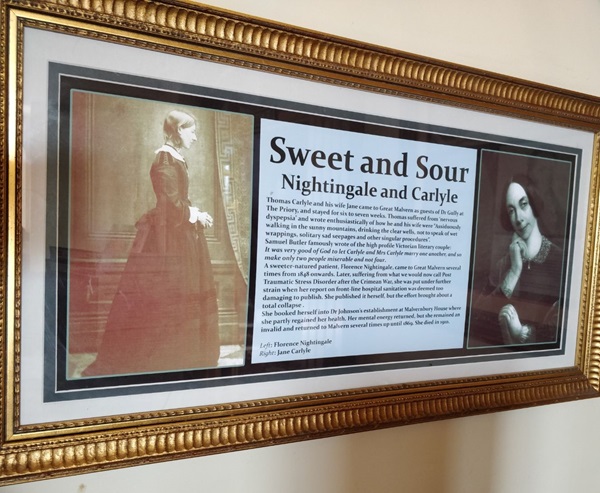
The text reads: Thomas Carlyle and his wife Jane came to Great Malvern as guests of Dr Gully at The Priory, and stayed for six to seven weeks. Thomas suffered from ‘nervous dyspepsia’ and wrote enthusiastically of how he and his wife were “Assiduously walking in the sunny mountains, drinking the clear wells, not to speak of wet wrappings, solitary sad seepages and other singular procedures”.
Samuel Butler famously wrote of the high profile Victorian literary couple: It was very good of God to let Carlyle and Mrs Carlyle marry one another, and so make only two people miserable and not four.
A sweeter-natured patient, Florence Nightingale, came to Great Malvern several times from 1848 onwards. Later, suffering from what we would now call Post Traumatic Stress Disorder after the Crimean War, she was put under further strain when her report on front-line hospital sanitation was deemed too damaging to publish. She published it herself, but the effort brought about a total collapse.
She booked herself into Dr Johnson’s establishment at Malvernbury House where she partly regained her health. Her mental energy returned, but she remained an invalid and returned to Malvern several times up until 1869. She died in 1910.
Left: Florence Nightingale
Right: Jane Carlyle
Text about Dame Laura Knight.
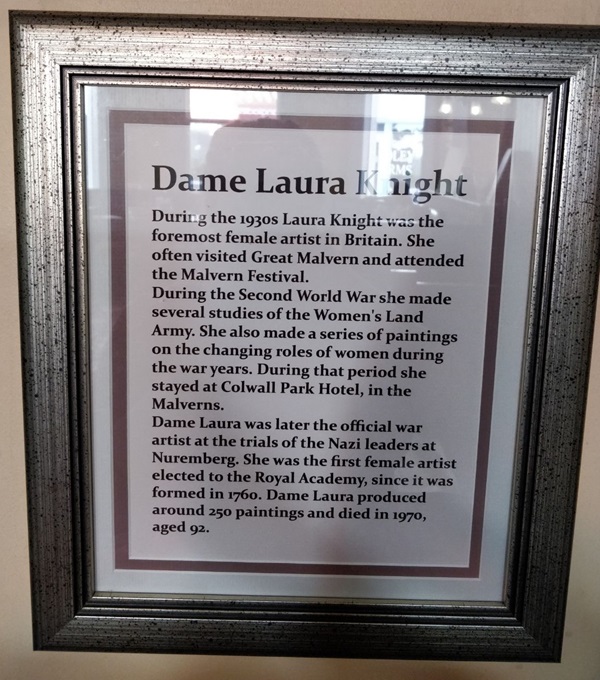
The text reads: During the 1930s Laura Knight was the foremost female artist in Britain. She often visited Great Malvern and attended the Malvern Festival.
During the Second World War she made several studies of the Women’s Land Army. She also made a series of paintings on the changing roles of women during the war years. During that period she stayed at Colwall Park Hotel, in the Malverns.
Dame Laura was later the official war artist at the trials of the Nazi leaders at Nuremberg. She was the first female artist elected to the Royal Academy, since it was formed in 1760. Dame Laura produced around 250 paintings and died in 1970, aged 92.
Prints and text about Thomas Attwood.
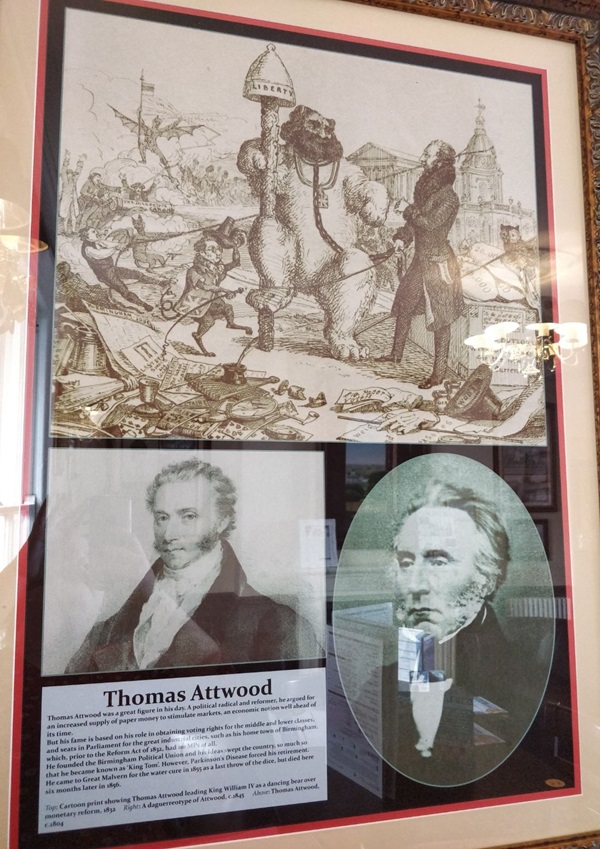
The text reads: Thomas Attwood was a great figure in his day. A political radical and reformer, he argued for an increased supply of paper money to stimulate markets, an economic notion well ahead of its time.
But his fame is based on his role in obtaining voting rights for the middle and lower classes and seats in Parliament for the great industrial cities, such as his home town of Birmingham, which, prior to the Reform Act of 1832, had no MPs at all.
He founded the Birmingham Political Union and his ideas swept the country, so much so that he became known as ‘King Tom’. However, Parkinson’s Disease forced his retirement. He came to Great Malvern for the water cure in 1855 a last thrown of the dice, but died here six months later in 1856.
Top: Cartoon print showing Thomas Attwood leading King William IV as a dancing bear over monetary reform, 1832
Right: A daguerreotype of Attwood, c1845
Above: Thomas Attwood, c1804.
Photographs, prints and text about the ‘Water Cure’.
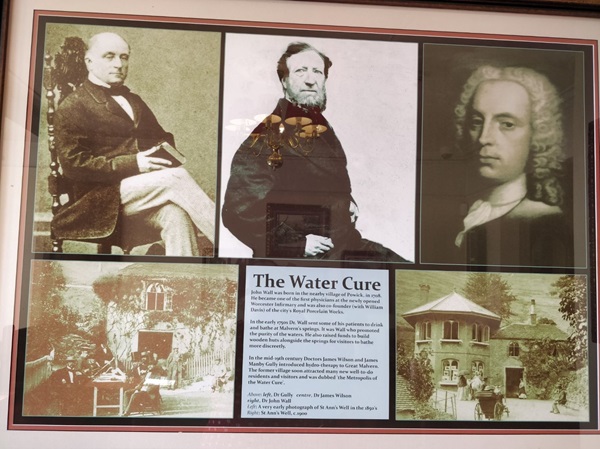
The text reads: John Wall was born in the nearby village of Powick, in 1708. He became one of the first physicians at the newly opened Worcester Infirmary and was also co-founder (with William Davis) of the city’s Royal Porcelain Works.
In the early 1750s Dr Wall sent some of his patients to drink and bathe at Malvern’s springs. It was Wall who promoted the purity of the waters. He also raised funds to build wooden huts alongside the springs for visitors to bathe more discreetly.
In the mid-19th century Doctors James Wilson and James Manby Gully introduced hydro-therapy to Great Malvern. The former village soon attracted many new well-to-do residents and visitors and was dubbed ‘the Metropolis of the Water Cure’.
Above: left, Dr Gully, centre, Dr James Wilson, right, Dr John Wall
Left: A very early photograph of St Ann’s Well in the 1850’s
Right: St Ann’s Well, c1900.
Photographs, prints and text about Jenny Lind.
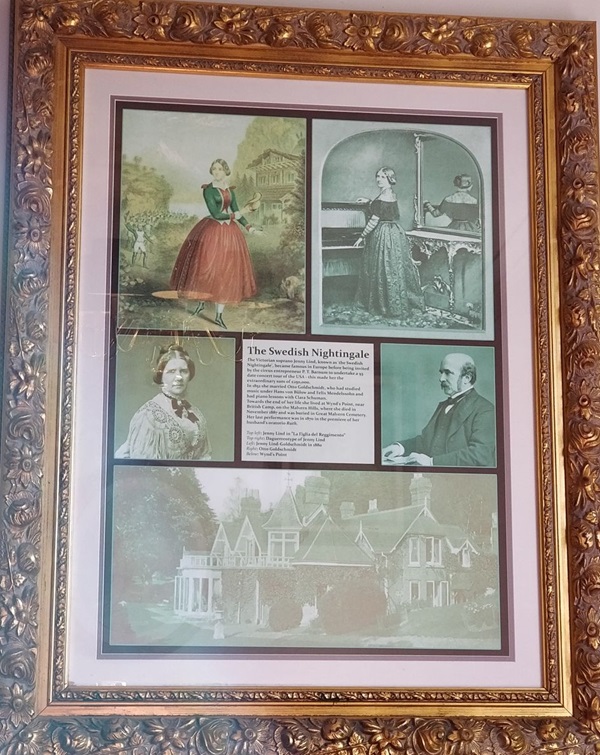
The text reads: The Victorian soprano Jenny Lind, known as ‘the Swedish Nightingale’, became famous in Europe before being invited by the circus entrepreneur PT Barnum to undertake a 93 date concert tour of the USA – this made her the extraordinary sum of £250,000.
In 1852 she married Otto Goldschmidt, who had studied music under Hans von Bulow and Felix Mendlessohn and had piano lessons with Clara Schuman.
Towards the end of her life she lived at Wynd’s Point, near British Camp, on the Malvern Hills, where she died in November 1887 and was buried in Great Malvern Cemetery. Her last performance was in 1870 in the premiere of her husband’s oratorio Ruth.
Top left: Jenny Lind in La Figia del Reggimento
Top right: Daguerreotype of Jenny Lind
Left: Jenny Lind-Goldschmidt
Right: Otto Goldschmidt
Below: Wynd’s Point.
Photographs, illustrations and text about ‘Little Annie’.
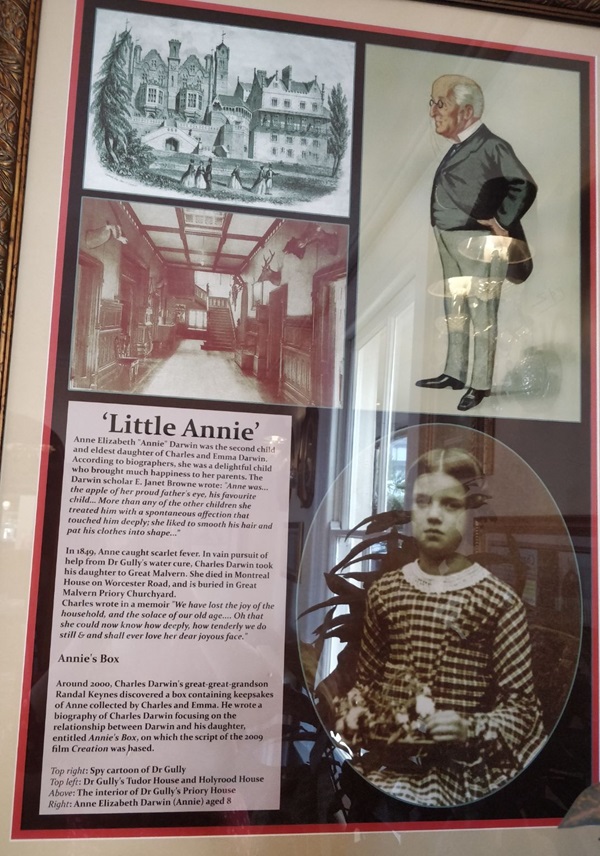
The text reads: Anne Elizabeth “Annie” Darwin was the second child and eldest daughter of Charles and Emma Darwin. According to biographers, she was a delightful child who brought much happiness to her parents. The Darwin scholar E Janet Browne wrote: “Anne was… the apple of her proud father’s eye, his favourite child… More than any of the other children she treated him with a spontaneous affection that touched him deeply; she liked to smooth his hair and pat his clothes into shape…”
In 1849, Anne caught scarlet fever. In vain pursuit of help from Dr Gully’s water cure, Charles Darwin took his daughter to Great Malvern. She died in Montreal House on Worcester Road, and is buried in Great Malvern Priory Churchyard.
Charles wrote in a memoir “We have lost the joy of the household, and the solace of our old age… Oh that she could now know how deeply, how tenderly we do still & and shall ever love her dear joyous face.”
Around 2000, Charles Darwin’s great-great-grandson Randal Keynes discovered a box containing keepsakes of Anne collected by Charles and Emma. He wrote a biography of Charles Darwin focusing on the relationship between Darwin and his daughter, entitled Annie’s Box, on which the script of the 2009 film Creation was based.
Top right: Spy cartoon of Dr Gully
Top left: Dr Gully’s Tudor House and Holyrood House
Above: The interior of Dr Gully’s Priory House
Right: Anne Elizabeth Darwin (Annie) aged 8.
Illustrations, photographs and text about Malvern Priory.
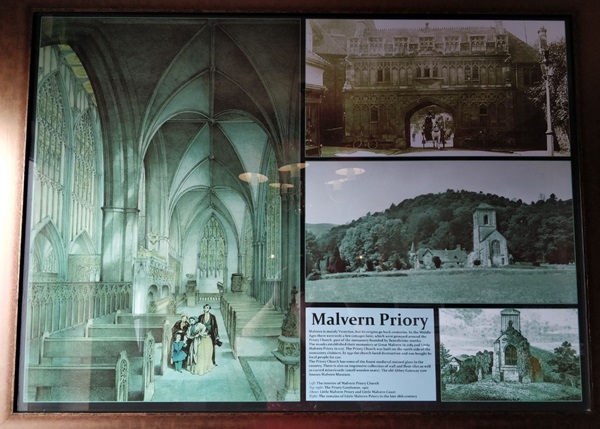
The text reads: Malvern is mainly Victorian, but its origins go back centuries. In the Middle Ages there were only a few cottages here, which were grouped around the Priory Church, part of the monastery founded by Benedictine monks. The monks established their monastery at Great Malvern in 1085 and Little Malvern Priory in 1127. The Priory Church was built on the north side of the monastery cloisters. In 1541 the church destruction and was bought by local people for £20.
The Priory Church has some of the finest medieval stained glass in the country. There is also an impressive collection of wall and floor tiles as well as carved misericords (small wooden seats). The old Abbey Gateway now houses Malvern Museum.
Left: The interior of Malvern Priory Church
Top right: The Priory Gatehouse, 1910
Above: Little Malvern Priory and Little Malvern Court
Right: The remains of Little Malvern Priory in the late 18th century.
External photograph of the building – main entrance.
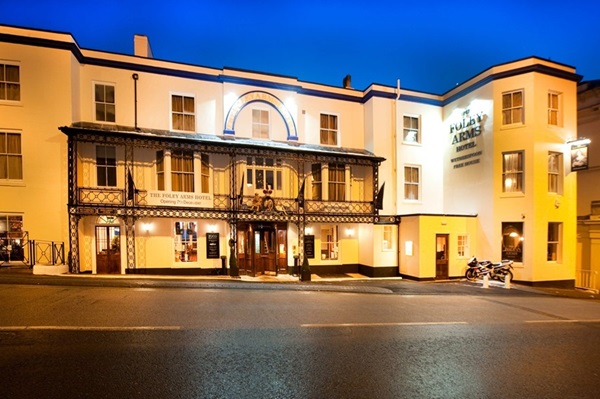
If you have information on the history of this pub, then we’d like you to share it with us. Please e-mail all information to: pubhistories@jdwetherspoon.co.uk